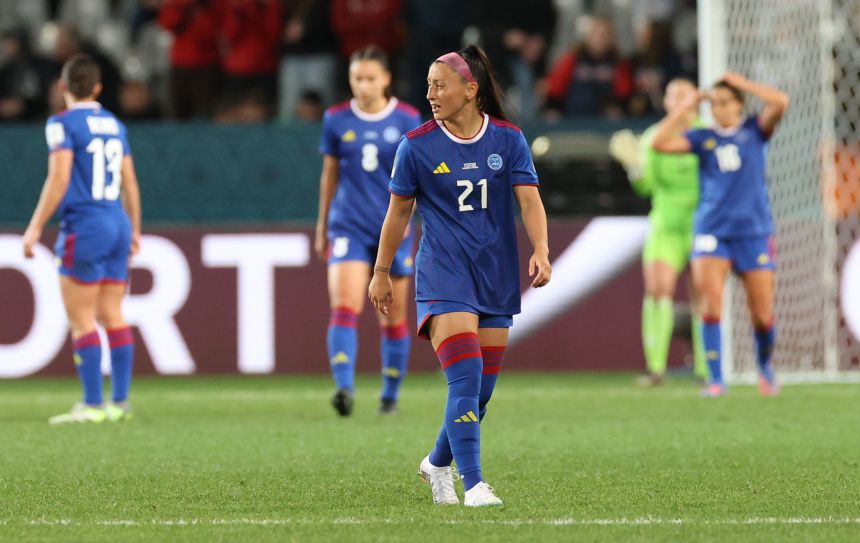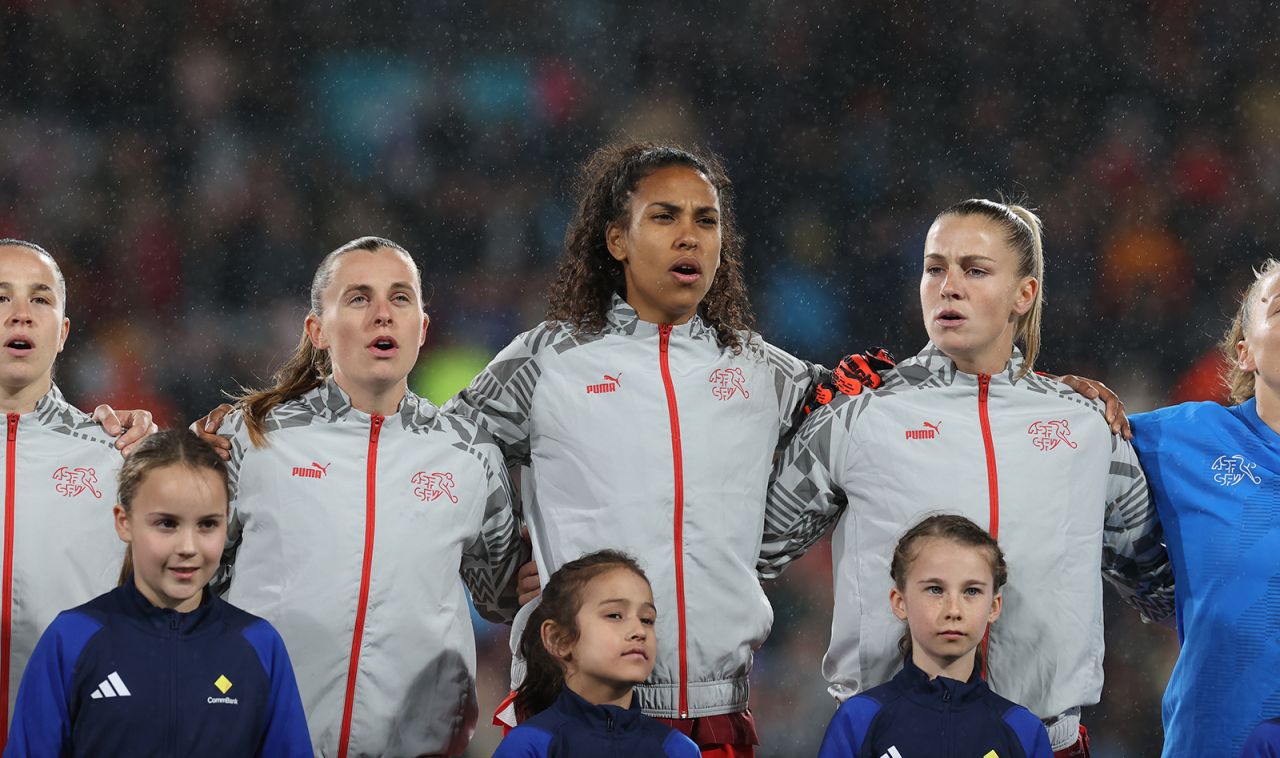December 12, 2023
American colleges feed the Women’s World Cup with talent. Will the future be different?

Katrina Guillou, who was born in the United States and played collegiate soccer at the University of North Carolina Wilmington, was a member of the Philippines national team at the 2023 Women’s World Cup.
Credit: Matthew GelhardKatrina Guillou stood on a soccer pitch in Dunedin, New Zealand, surrounded by teammates, dejected.
A Filipina forward playing for her national team, Guillo had just seen her goal called back. A beautiful pass had allowed Guillou to step past the Swiss keeper, take another touch to her right, and slot the ball into the net. Had Guillou been onside, it would have been the Philippines’ first-ever goal at a Women’s World Cup.
On the other side of the pitch, Swiss midfielder Coumba Sow was feeling a bit better about her chances of avoiding an upset by the Filipinas. Indeed, the Swiss wound up winning 2-0. Sow had already established herself within the Swiss team, recording 14 goals for Switzerland in her 33 appearances since 2018.
There isn’t much that Sow and Guillou have in common. Sow was born and raised in the country she represents at the international level. Guillou was born in the United States, but family heritage allowed her to represent the Philippines.
Despite their differences, Guillou and Sow share one critical part of their life stories: Both attended American colleges.
The educational path they shared has a long history in soccer, tracing back more than 50 years to the origins of Title IX, which led to a huge investment in women’s sports in America.
The U.S. collegiate system has given American women athletic dominance on the global stage while allowing international players to compete at a high level as they earn degrees. But now, the American model has become somewhat less attractive as the rest of the world looks for ways to match its success.
Guillou, who played soccer at the University of North Carolina Wilmington, and Sow, who played at Oklahoma State, were two of the 135 former or current U.S. collegiate soccer players representing their countries at the Women’s World Cup last summer. Those players made up more than one in six of all athletes at the tournament.
Equal rights, better teams
Title IX, part of the Educational Amendments Act of 1972, changed the landscape of American sports by guaranteeing the right to gender equality in U.S. education. As much as Title IX applied to law school applications and classroom material in high schools, it also ensured that schools and universities across the United States would have to give female student-athletes the same resources – the same facilities, scholarship funding, and more – as their male counterparts.
When Title IX passed, approximately 23,000 women competed at the collegiate level, said Ellen Staurowsky, a sports media professor at Ithaca College and an expert in gender equity and Title IX. Now, there are approximately a quarter-million women college athletes. The high school level has also seen waves of women student-athletes, up to 3 million today from 250,000 in 1972.
Title IX has allowed for women’s soccer players to follow a route to success vastly different from that of male players. While plenty of European clubs were uninterested in investing in women’s soccer 51 years ago, American institutions were bound by the law to treat their women athletes as well as the men. And while men have flocked to European academies to train and develop, the American collegiate path has long stood as a model for women’s soccer players to hone their skills – and it’s helped the U.S. in many other sports.
American women were so successful at the 2021 Tokyo Olympics that, had U.S. women been their own country, their 66 medals would have placed fourth in the overall medal count, behind the United States as a whole, China and the Russian Olympic Committee.
It’s reasonable to argue that Title IX is the reason United States soccer teams have won four of the nine Women’s World Cups in the tournament's history.
Non-Americans benefit, too
International players and their teams also have benefited from major-college women’s soccer.
Of the 135 former or current collegiate players who participated in the 2023 Women’s World Cup, 115 played for non-American teams. Smaller nations thrived, with the rosters of teams like Jamaica, which made it to the knockout round, the Philippines, Costa Rica and New Zealand featuring high numbers of former or current NCAA athletes.
There’s a sharp contrast between the American and European systems. Many international players take the option to stay at home and play with a club that they know. But others feel it’s best to take the risk and go to the United States.
However, just because foreign athletes are using opportunities at U.S. colleges to further their athletic careers doesn’t mean it’s an easy road. Many enroll at American universities not knowing exactly where they’re going or what the American collegiate experience will be like.

Switzerland’s Coumba Sow, center, sings the Swiss national anthem ahead of the Women’s World Cup Group A soccer match between Switzerland and Norway in Hamilton, New Zealand on July 25, 2023.
Credit: Juan Mendez“I didn't understand the system. I was in a rush to just go to the States. I wanted to keep on learning a language and studying and also play soccer. It's a lot of paperwork, so I just looked at the facility. I was like, ‘Oh, New York,’ and I went,” said Sow, who attended Monroe Community College in Rochester, New York, for two years. “Then I got there I was like, `OK, maybe I should have checked it out better.’”
Sow’s experience wasn’t unique, said Nicole LaVoi, a Title IX expert and former collegiate tennis coach.
“The educational systems around the globe are so different that our international students really don't know how to navigate the system of the U.S. educational entity,” she said. “And so unless they have someone that guides and mentors them, maybe in their home country or here in the U.S., it's really hard to navigate.
“Coaches sort of become that proxy of educating student athletes in different countries, helping them through the system because they want them to matriculate and join their teams.”
These days, many European clubs and coaches are discouraging players from playing collegiate soccer in the United States and urging them to join clubs in Europe, said Dave Nolan, the head coach of Georgetown women’s soccer.
European teams prefer their own system, which is the traditional structure for most of the men’s soccer world. A player will enter the academy for a European club and play with its youth level teams for years. If the club feels that a player is ready, it may sign that player to a senior contract and place that player on the first team. If the club doesn’t find a player suitable for first-team minutes, they are often released to find a new home on their own.
But Nolan argued that European coaches' concerns about the American way are based on misconceptions of it.
“There’s a little bit of ignorance from some of the national team coaches, they’re not interested in learning more (about the system),” Nolan said. “Some of those coaches would be pushing kids to play in the second division in Germany for $50 a week or $100 a week.”
That’s not a great option financially, Nolan said, and doesn’t prepare a player for the highest levels of the sport.
Unless smaller European clubs are willing to pay more money, the Division I route will likely be a more secure and smarter one for many players.
“Until these players are making millions, I think an education is going to be the most important thing for these young women. The highest level is only for the 1%,” said Erica Dambach, the head coach of Penn State women’s soccer, who has also worked as an assistant for the U.S. women’s national team. “I believe that it will stay relevant.”
Setting academics aside, players said that Division I schools offered a different style of play that helped their development. Sow said that while the culture of the schools she attended was much more positive than teams in Europe, the Americans also made her a more physical player, which has helped her in her professional career in Switzerland and France.
College soccer scheduling can also toughen up the international players. While it’s only three months long, the season is intense – schools frequently play twice a week – especially when paired with scrimmages in the offseason. For Guillou, the grind helped her build up the stamina she needed to play professionally.
Compare that with the schedule of a typical European professional team. All teams playing in England’s Women’s Super League play 22 games from early October to late May, just over eight months in total. In comparison, a collegiate team plays from just August to November or December, depending on its success in the postseason.
“It was definitely a great experience for me. I can't really speak for the others, but the way the season is with everything so condensed into the three-month span, playing two games every week. I think it really helps build the stamina that's needed,” said Guillou, who's played professionally in Finland and Sweden. “And coming to this level, I think I've been able to build on top of that, and also playing games in Europe right now. I think it's really helpful.”
Sow agreed and said she’s noticed a difference in her style of play.
“I think before I went to the U.S. I wasn't really a physical player,” Sow said. “I learned how to fight in the U.S. because it's a lot, a lot of long balls. You have to fight for the second ball.”
European investment
While playing in Europe may be meant for the top 1%, major European clubs have begun to pump more money into the women’s game. Some of the best teams in England, Spain, and Germany making serious investments in their women’s sides.
These days, competition for young stars is fierce, said University of Michigan professor Andrei Markovits, an author who researches sports culture and has focused on women’s soccer. The future of American women’s soccer hangs on the attractiveness of college soccer to young stars.
The way Markovvits sees it, it comes down to whether a young woman wants to play for North Carolina or Real Madrid. “Will the Tar Heels, with their 24 NCAA championships and their amazing coach, Anson Dorrance, still continue to hold their own and actually surpass Real Madrid?” Markovits said. “The 12-year-old brilliant phenom from Fresno, California -- is it important to her culturally to be a star with Manchester City or United?”
It’s a difficult question for Markovits to answer.
Aitana Bonmatí, recently named the top player in the world for the women’s game, had an offer to play soccer at Oregon. The Spanish player committed to the Ducks, but ultimately signed a contract to play for FC Barcelona Feminí in 2012. Eleven years later, she brought a world championship and her own trophy back to Barcelona’s home at Camp Nou.
“I just fear that ultimately North Carolina will not be able to keep pace with Real Madrid. Just by virtue of financing, by virtue of prominence, by virtue of cultural capital, by virtue of prestige, by virtue of glamor, it's a bigger deal to play for Real Madrid than to play for North Carolina,” Markovits said. “At the moment, that's not the case for women.
“Let's talk again in 10 years.”